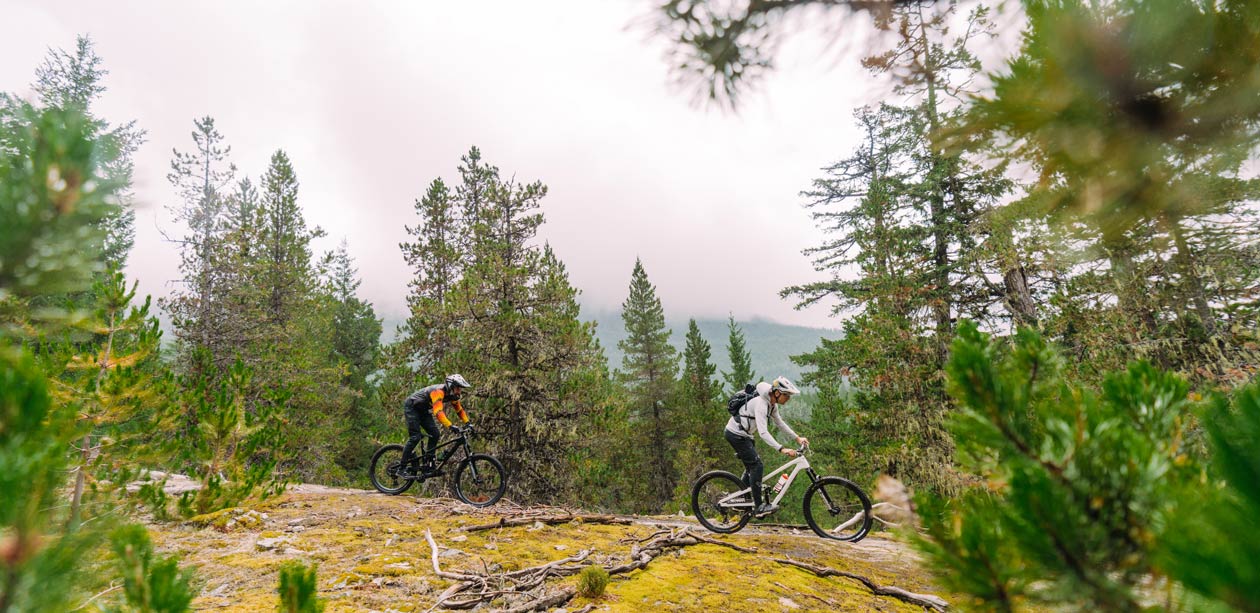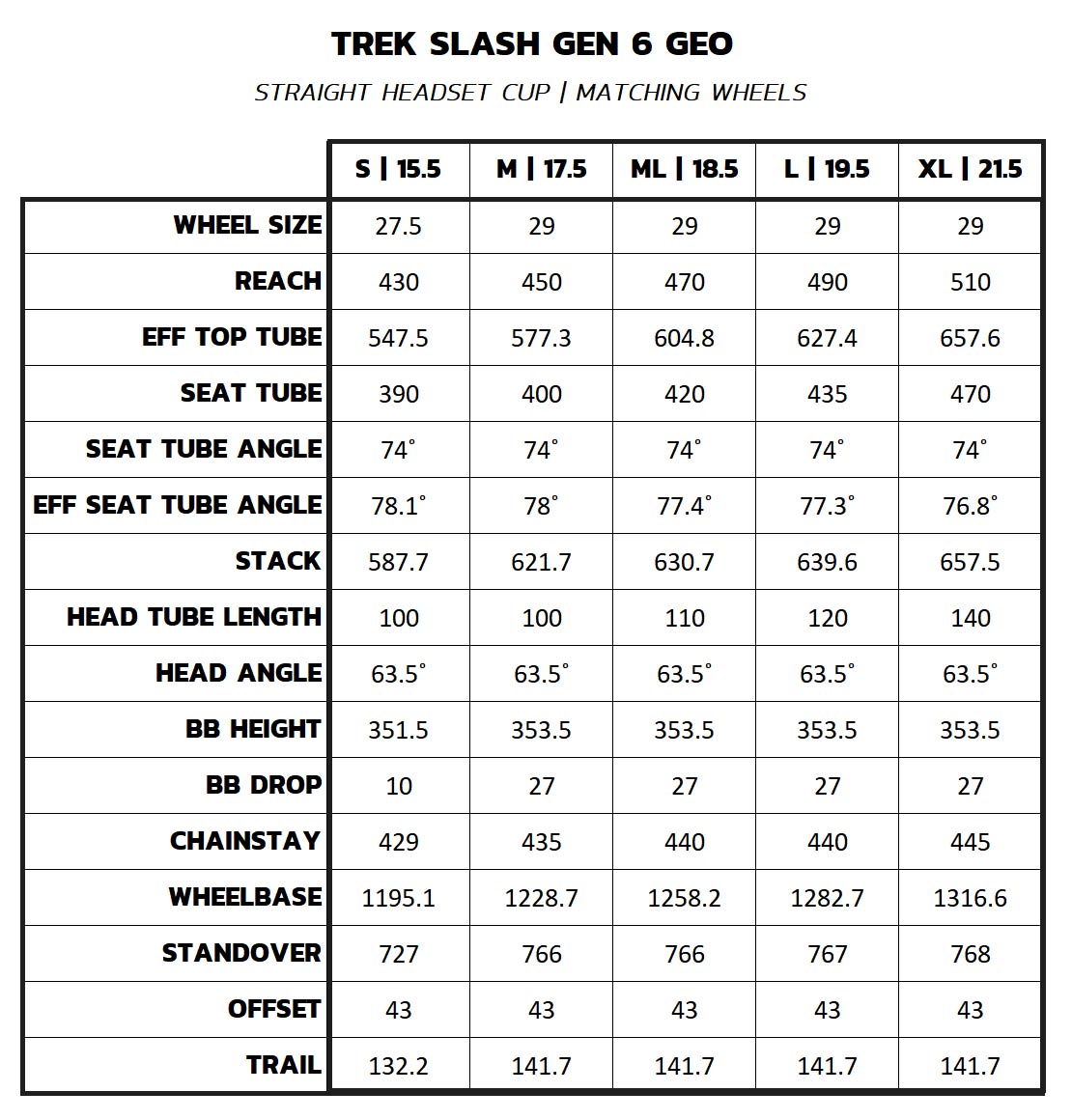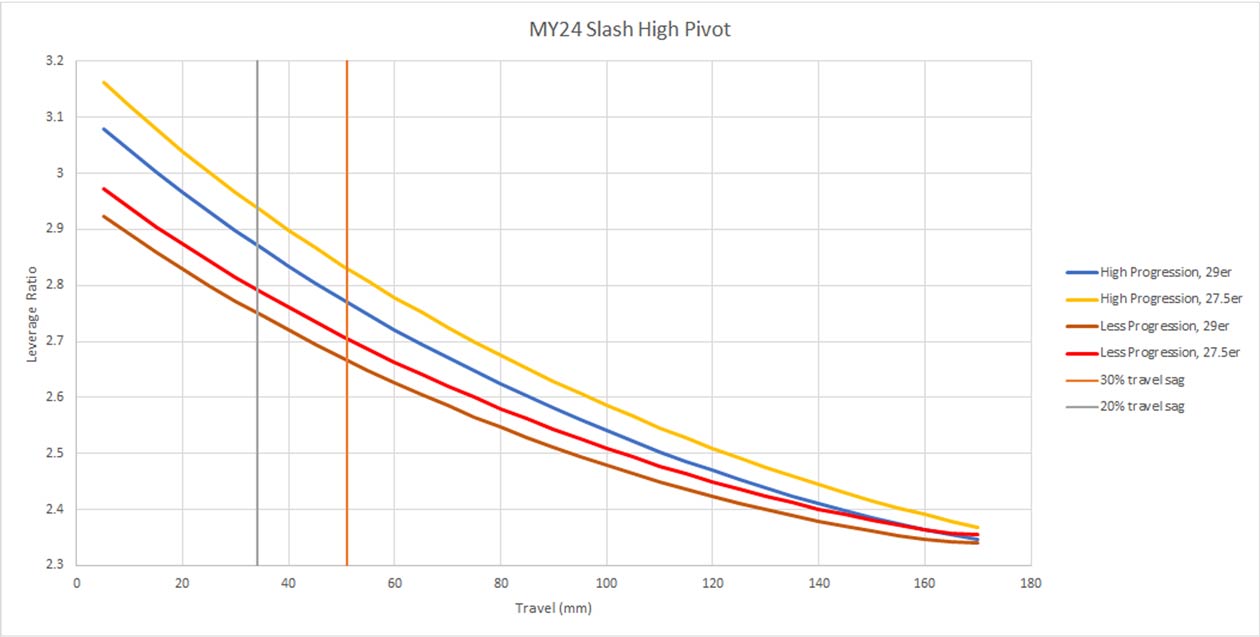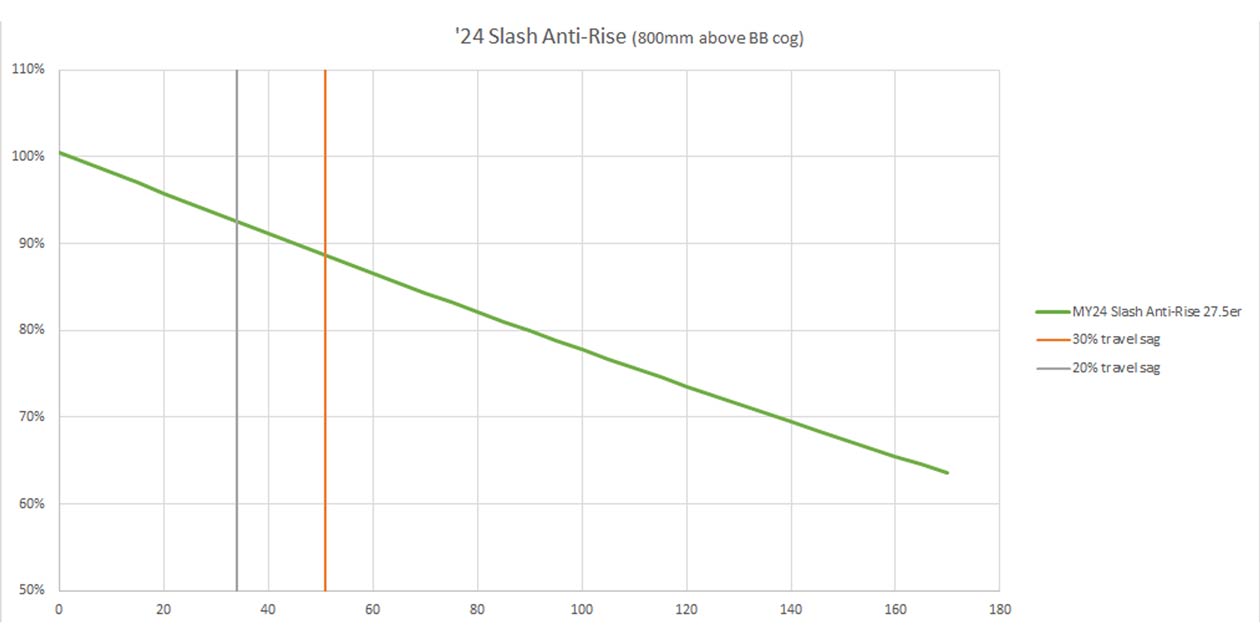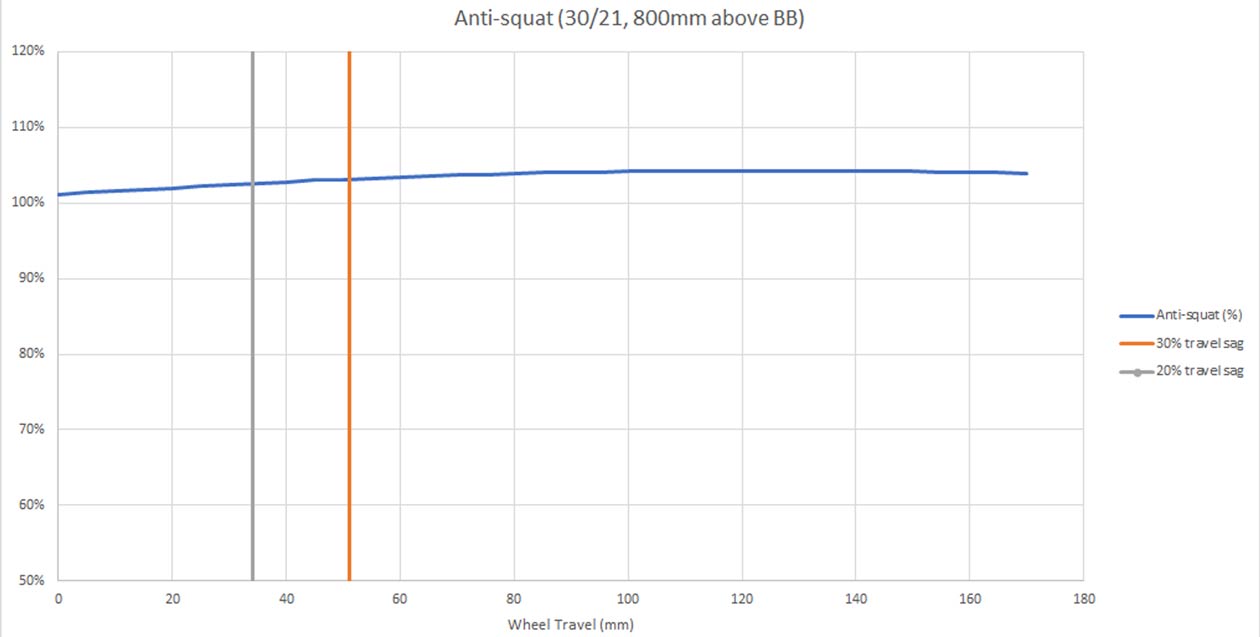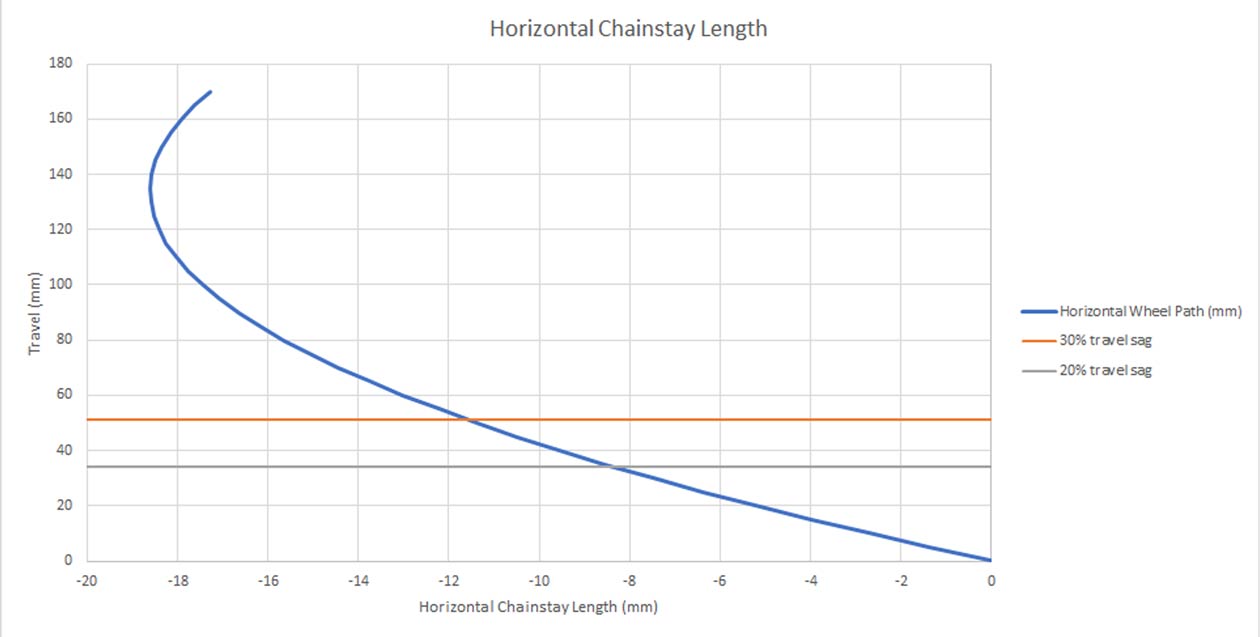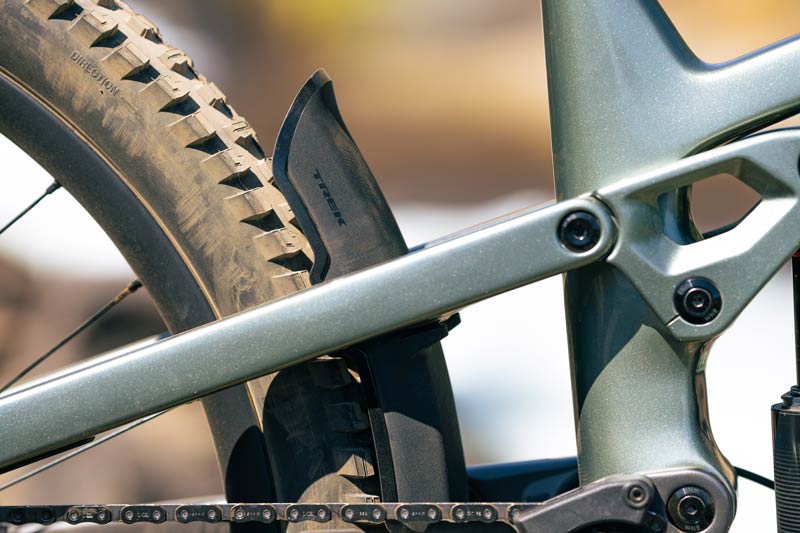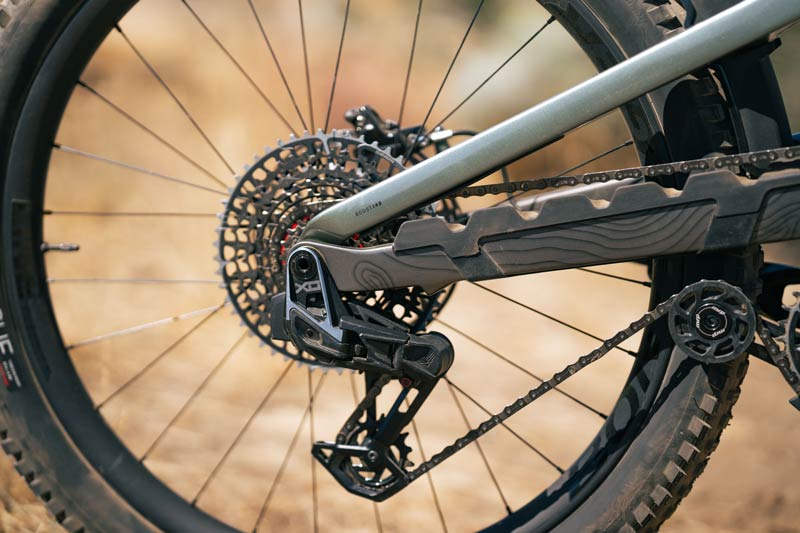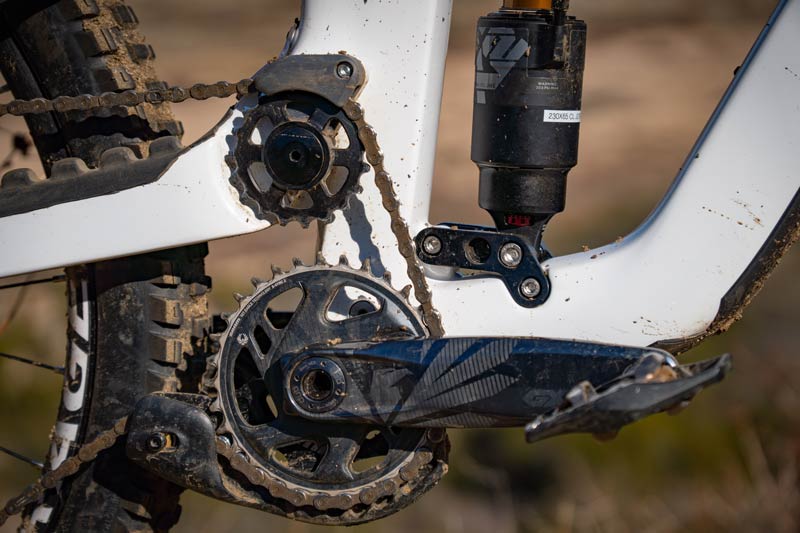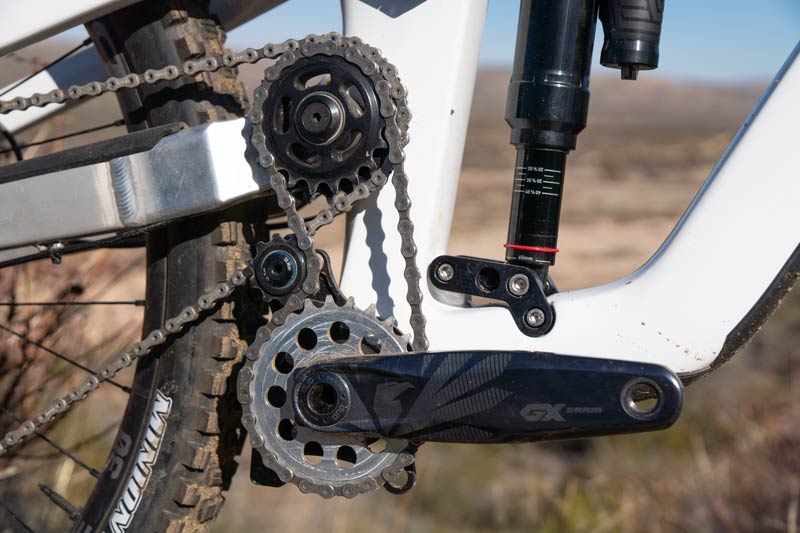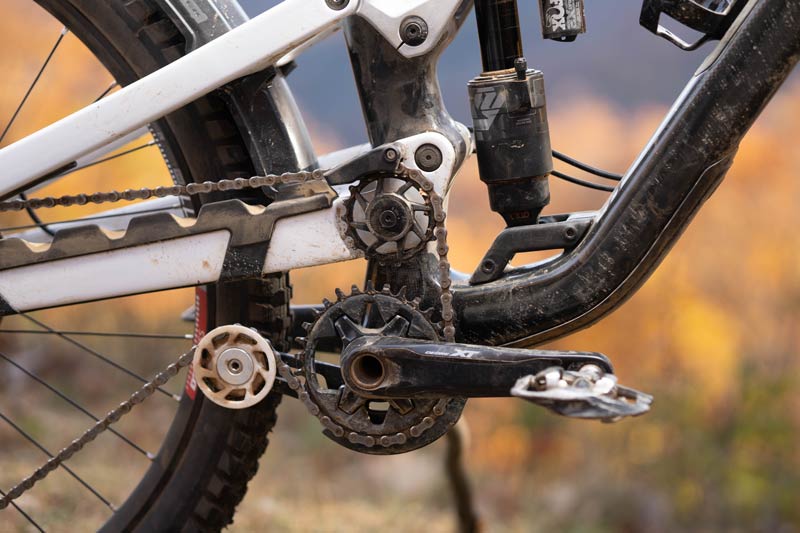
TREK SLASH GEN 6
UPPING THE GAME
Words by Drew Rohde | Action Photos by Dusten Ryen
Edited by Brian Niles/Treeline Cinematics
SPONSORED CONTENT
Redesigned from the ground up and looking nothing like the outgoing Trek Slash, you could almost say the sixth generation, 2024 Trek Slash looks almost like….a Session. There we said it. The new Trek Slash features a high pivot suspension design with a double-pulley design for both pedaling and downhill performance perks. The 2024 Slash also gets more travel, more aggressive and more adjustable geometry, the ability to run different-sized wheels, and some frame durability enhancements to boot. We were lucky enough to get some early rides on the Gen 6 Trek Slash in Whistler during Crankworx, and have been sneaking it on the chairlift at our local bike park since then. Let’s Dissect some of the many finer details found on Trek’s latest high-pivot, aggressive mountain bike offering.
DISSECTED DISCLAIMER | As with all of our Dissected Features, this is not intended to be a long term review or endorsement of a product but is instead a chance for our viewers and readers to get a deep dive look into some of the newest tech and products in the mountain bike space. We thank Trek Bicycles for the opportunity to create this feature and offering a more in-depth look into the production and changes of the latest generation Slash.

MEET THE NEW TREK SLASH
With the Top Fuel getting bumped into the Trail category and the Trek Fuel EX also getting the longer, slacker and more aggressive treatment, Trek Bicycles stepped back to take a hard look at what the next generation Slash should be.
Boasting 170mm of travel front and rear, the Slash’s intentions have certainly risen to what it seems riders and the industry are demanding. Bigger travel bikes that can pedal and are equipped with DH-bike geometry seem to be more commonplace these days and Trek wasn’t about to let their flagship Enduro Race Bike fall behind. We’d actually say that Trek has actually made the new Slash even more versatile than the outgoing, 29er Slash, which was very much a race-focused machine.
By allowing riders to run either a 27.5” (OE Spec) or 29” rear wheel, and being able to use up to a 190mm fork up front, Trek’s new Slash can be the ultimate race rig or the freeride, big-hitting park rat’s dream machine.
Size medium bikes and up come with a mixed wheel setup, whereas size small Slashes will come with 27.5” front and rear, just like our friend Casey Brown’s bike, seen here. Watching a rider of her height pop, shred and climb some techy, wet and root-littered trails north of Whistler was a fun experience, and her excitement about having more control over the bike thanks to the smaller wheels was evident. Also exciting for riders is the roughly 80mm increase in dropper post insertion. This means that size medium bikes can run a 200mm dropper. Longer droppers for everyone!
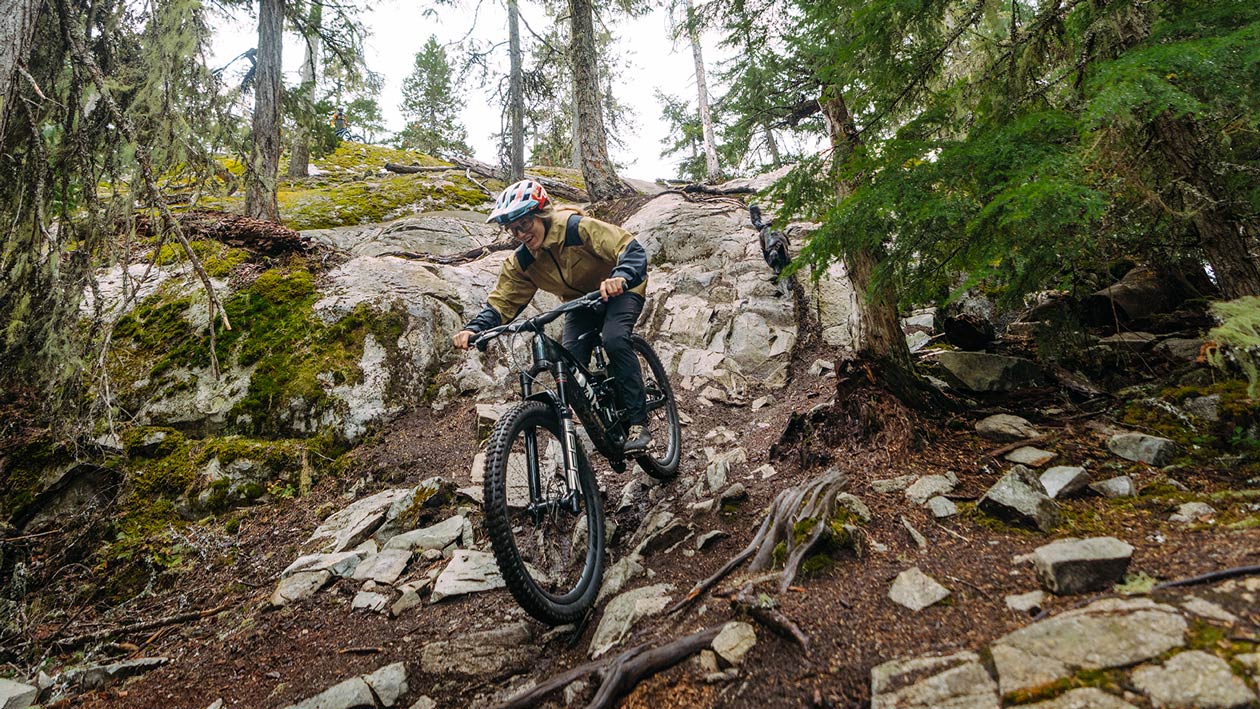
GEOMETRY | Trek Bicycles will be offering the Slash in five sizes from Small to XL, with a Med/Large midway through the range. Coming in with a half-degree slacker head tube angle in the nominal position, the Slash sits at 63.3 degrees with the mixed-wheel configuration. Sold separately are headset cups for those who want to take advantage of the ability to add or subtract a full degree from that head tube angle number. There is also a changeable lower shock mount that changes BB height for smaller adjustments and to offset the change from swapping wheel sizes. Not geometry related but also adjustable is the compression ratio, which goes from 20% to 25%.
Along with the slackening of the headtube angle and adding to the bike’s adjustability, the new 2024 Slash will have a 77-degree seat tube angle, 351mm BB height, 27mm BB drop, size specific chainstays achieved by shifting bottom bracket position in the front triangle and an overall wheelbase of 1,277.7mm for the size large mixed wheel configuration.
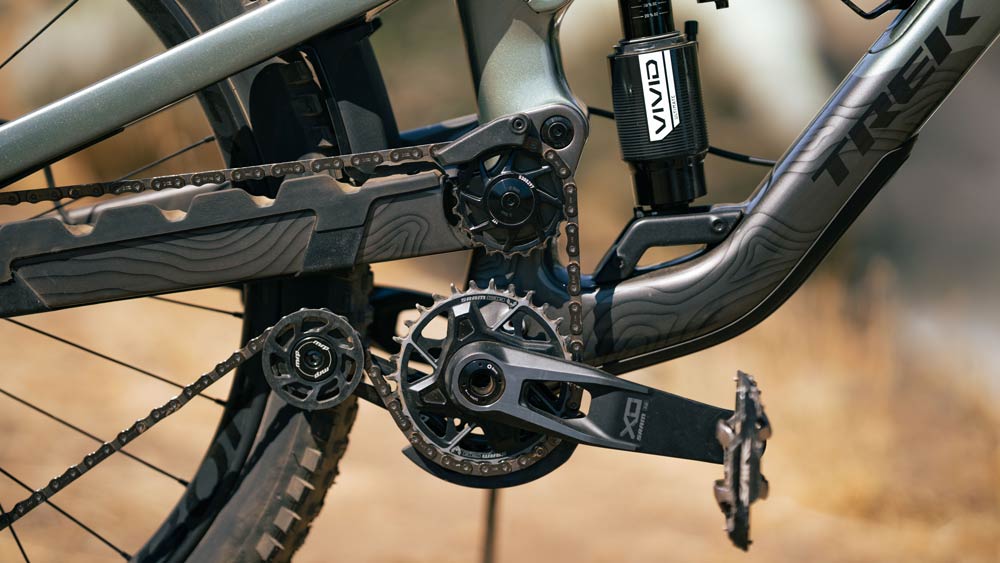
TWO IDLERS?
By now most of you have probably heard or experienced the claimed benefits, and maybe even the downsides, of high pivot mountain bikes. With Trek acknowledging the downhill bias of the new Slash, calling it a 70/30 bike, engineers and athletes still wanted – no, needed – a bike that would climb well. Trek has worked a couple of angles to help offset the high pivot’s climbing woes by adding an oversized 19-tooth upper idler to help reduce pedal kickback as well as help manage Trek’s very high and flat anti-squat curve. On average the new Slash has more anti-squat than the Top Fuel, Trek’s XC pinner, which should provide lots of support in the suspension for those finish line sprints or quick cranks before a big gap.
Behind the chainring you’ll notice something some other high pivot bikes don’t have, a lower idler. We talked with the Trek Slash engineer about that down below in our interview and in the video, so check that out to learn all about why they added this second pulley, but the benefits were definitely felt and seen on the trail.
Other Key Feature Bullet Points
- The improved internal storage compartment features a bigger opening, easier to reach latch and channels to eliminate most catch point issues, like cables.
- An attention grabbing chainstay guard has a unique shape that was painstakingly studied. It doesn’t just dampen impacts and noise, it also prevents the chain from whipping, which is good for just about everything. We can attest it works and keeps the chain tight, quiet, and working smoothly.
- Trek wanted to improve the impact resistance of the Slash and have added an impact-resistant, impregnated film under the paint. Along with this extra layer of protection, dual-density downtube guards are replaceable and designed to be removed to inspect the frame behind the protectors.
- A very slick and functional rear fender works to keep debris and mud from collecting in the rear end of the bike. Trek says the fender will not work with 29” rear wheels but after some inspection, we think it’d work alright with some 29’er tires that aren’t too voluminous or caked in thick mud.
MODELS
Trek will offer two aluminum models, an entry-level Slash 8 with XT components and Fox Rhythm suspension. There will also be a higher-spec’d Slash 9 GX AXS with RockShox Zeb Select + and Vivid Select + suspension, a worthy consideration for alloy shredders. Also available will be an aluminum and carbon fiber frame set.
Carbon models will begin with the 9.8 GX AXS and Zeb/Vivid Select + components. From there riders will work up the normal Trek ladder with 9.8 XT, 9.0 X0 AXS, 9.9 XTR and 9.9 XX AXS builds.

ALLOY BUILDS
TREK SLASH 8
Frame: Alpha Platinum Aluminum | 170mm
Fork: Fox Rhythm 36 | 170mm
Shock: Fox Performance Float X
Drivetrain: Shimano XT
MSRP: $4,399.99
TREK SLASH 9
Frame: Alpha Platinum Aluminum | 170mm
Fork: RockShox ZEB Select+ | 170mm
Shock: RockShox Vivid Select+
Drivetrain: SRAM GX Eagle AXS
MSRP: $5,799.99
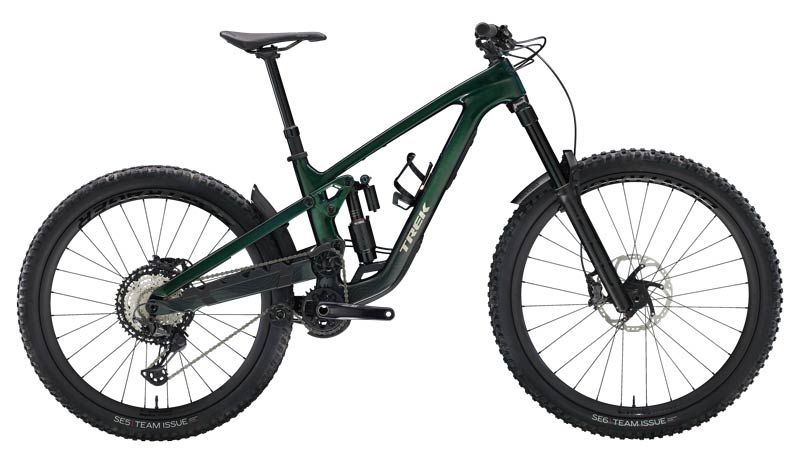
9.8 BUILDS
TREK SLASH 9.8 XT
Frame: OCLV Mountain Carbon | 170mm
Fork: RockShox ZEB Select+ | 170mm
Shock: RockShox Vivid Select+
Drivetrain: Shimano XT
MSRP: $7,399.99
TREK SLASH 9.8 GX AXS
Frame: OCLV Mountain Carbon | 170mm
Fork: RockShox ZEB Select+ | 170mm
Shock: RockShox Vivid Select+
Drivetrain: SRAM GX Eagle AXS
MSRP: $7,999.99
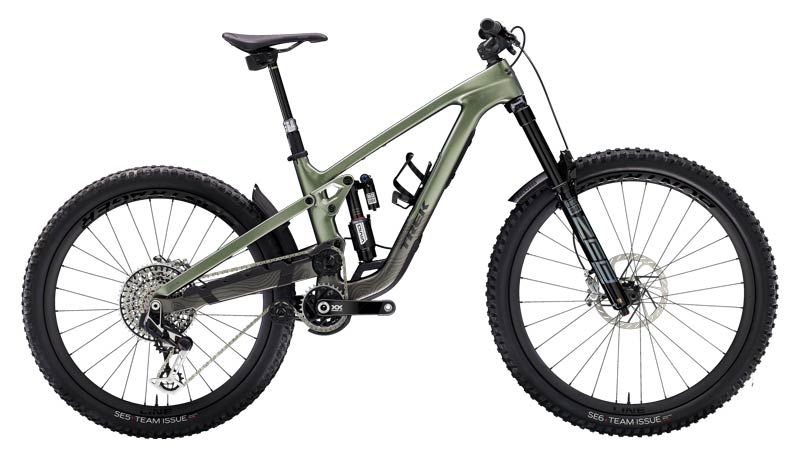
9.9 BUILDS
TREK SLASH 9.9 X0 AXS
Frame: OCLV Mountain Carbon | 170mm
Fork: RockShox ZEB Ultimate | 170mm
Shock: RockShox Vivid Ultimate
Drivetrain: SRAM X0 Eagle AXS
MSRP: $9,399.99
TREK SLASH 9.9 XTR
Frame: OCLV Mountain Carbon | 170mm
Fork: RockShox ZEB Ultimate | 170mm
Shock: RockShox Vivid Ultimate
Drivetrain: Shimano XTR
MSRP: $9,599.99
TREK SLASH 9.9 XX AXS
Frame: OCLV Mountain Carbon | 170mm
Fork: RockShox ZEB Ultimate Flight Attendant | 170mm
Shock: RockShox Vivid Ultimate
Drivetrain: SRAM XX Eagle AXS
MSRP: $11,499.99
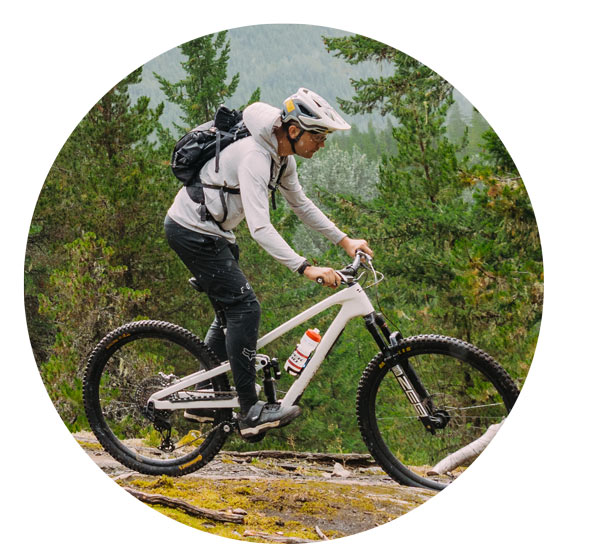
MATT YERKE
Trek Slash Engineer
While out on our ride we had the opportunity to ask Matt Yerke, Trek’s Slash engineer, way too many questions about bikes, tech, and other two-wheeled nerdery. Here are a few highlights pertaining to the new Slash.
TLW: WHAT WAS YOUR BIGGEST GOAL WITH THE NEW SLASH?
Matt Yerke (MY): Well, we knew the Slash was a fan and race team favorite, but we wanted to take some DNA from another race-winning race bike, the Session, and make it even more capable. Of course, pedaling is important for our enduro racers, so we had to make sure it could still get up the hill well.
TLW: MOST PEOPLE DON’T THINK A HIGH PIVOT IS A PEDAL-FRIENDLY OPTION. WHAT DID YOU DO TO KEEP THIS BIKE AS PEDAL-FRIENDLY AS POSSIBLE?
MY: We give the bike a high anti-squat and a very flat curve, which normally means a lot of pedal kickback, but thanks to the idler we don’t have to worry about that kickback.
TLW: WHAT SORT OF POWER REDUCTION CAN RIDERS EXPECT DUE TO THE TWO EXTRA WHEELS?
MY: We tested it and found that it’s only about 3 Watts of power.
SLASH IDLER EVOLUTION
TLW: WHY THE OVERSIZED PULLEY?
MY: The more you articulate or bend the links in a chain, the more power you lose. So, a larger wheel means less power loss.
TLW: WHAT DOES THE LOWER PULLEY MEAN FOR PERFORMANCE?
MY: Well, you can see how high it is, that’s a visual queue that things are different here. We worked with SRAM because they have a total amount of chain growth that is acceptable to keep the derailleur within spec. That’s important to maintain shifting performance as it keeps the upper pulley wheel closer to the cassette. A biproduct of that is that when you push on the suspension you’ll notice that the bottom of the derailleur cage does not move forward. This means the suspension is not feeling the impacts of the derailleur clutch pulling against the suspension movement.
TLW: SO, DOES THIS MEAN IT MAKES IT FEEL A BIT MORE LIKE A “CHAINLESS” EXPERIENCE?
MY: You could say it’s closer to that.
TLW: HAVE SOME OF YOUR TREK TEAM DOWNHILL RACERS BEEN EXPERIMENTING WITH A LOWER PULLEY LIKE THE SLASH?
MY: Absolutely, Loris has had it on his Session, and he has noticed some improvements and increased smoothness from the suspension.
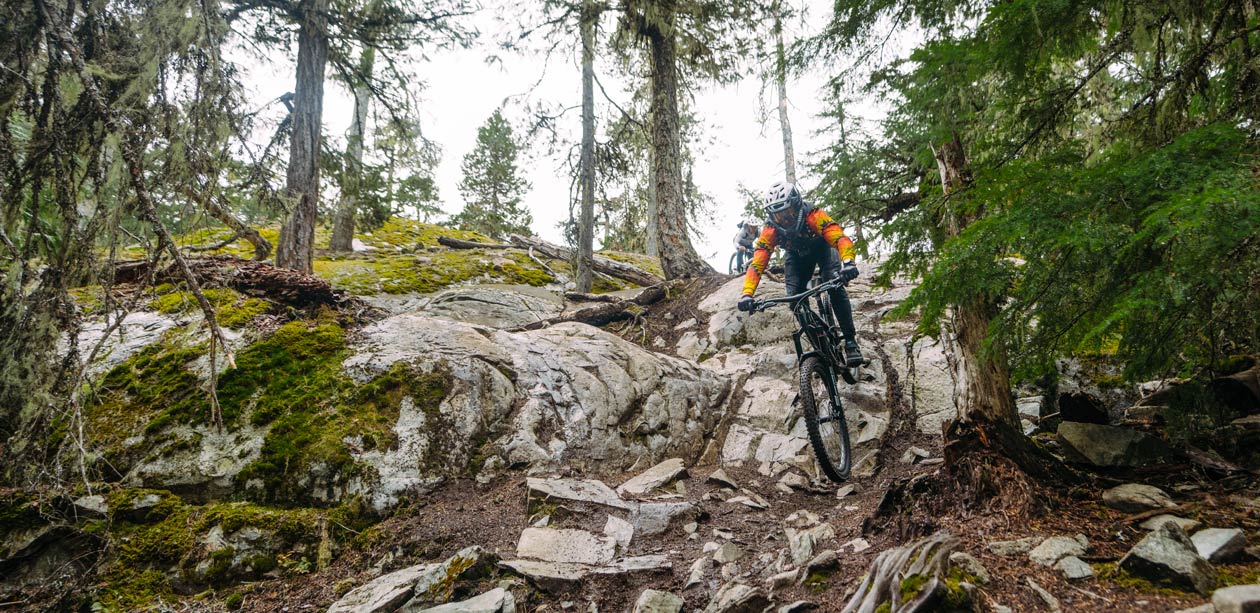
THE WOLF’S FIRST IMPRESSION
Obviously, there is a ton of technology, features and yes, marketing to digest when it comes to the new Trek Slash. We can’t wait to review the Trek Slash thoroughly but for now, we’ll have to just share our initial thoughts after a few very solid days riding in British Columbia and at Mt. Bachelor Bike Park.
First things first, getting up the hill. This is probably the one area I’m most uncertain about on the new Slash and think we need to do more testing and tuning on. I’ve found myself striking BB a little bit more often than I thought, and perhaps I’m just out of shape and spinning too easy of a gear, which results in more chances for my crank arm to be in striking distance. Aside from pedal strikes, the bike pedals better than some 170mm high pivot bikes on the market, but there’s no mistaking that it’s still a 170mm big mountain descender with a 63.5-degree head angle. Chances are, climbs aren’t what you live for if you’ve made it this far anyway. If you’re like us, you enjoy climbing as a bit of a tortuous challenge and being part of the experience, but really, it’s the downhills that you live for. And if that’s the case, the Slash will be a kindred spirit.
Dropping into some wet and slippery BC terrain as a dust and loose-rock loving desert rat can be very unnerving, yet the Slash quickly eased my mind as the quiet thudding of the bike ate up each root and rock slab with aplomb. In fact the only sketchy part about the ride was the Bontrager tires, which we’ll save for another day. The Trek Slash quickly stood out to me amidst the 40 or so bikes I’ve ridden in 2023.
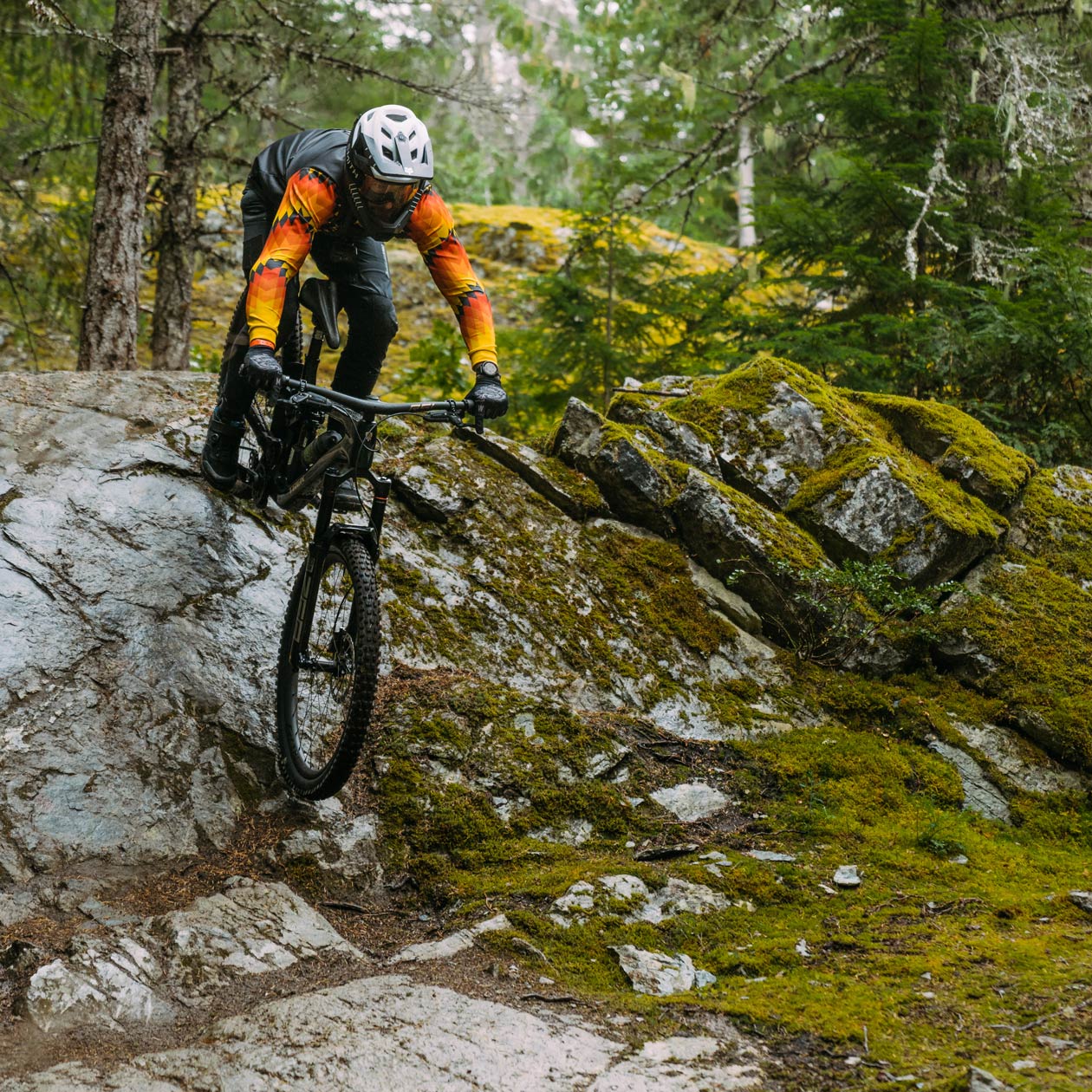
I really like bikes that have a supple and sensitive feel off the top, which reduces fatigue by quieting chatter. A calmer bike and body help keep me feeling confident and in control. The Slash and the new Vivid shock are a true power couple and required almost zero tuning to get me to a happy spot. I value bikes that can be set up quickly and allow me to push hard without needing to fuss around with tons of different settings, air pressures and reducers. Props to Trek on nailing a great tune for most riders.
The 488mm reach was a bit outside my desired zone at 5’11, as I like 480mm to 485mm (max) on non-electrified bikes. This resulted in a couple of scenarios where I felt the front end wanting to go over the edge of a tight berm or forcing me to use more Body English on tight switchback climbs, which was undoubtedly accentuated by that raked-out head tube. However, for the most part I felt right at home on the bike and really enjoyed it on everything from high-speed DH tracks to slower, technical BC black diamond trails.
While we make a point of remaining as neutral and factual as possible in our Dissected features as they are made with support and cooperation from the brands launching new products, I do feel pretty comfortable saying that the new Trek Slash ranks very high on my list of bikes ridden in the last two years. If climbing takes a back seat to downhill capabilities – fun, charging hard and going big – you may not want to wait until we’ve logged enough miles for our long-term review to pull the trigger.
